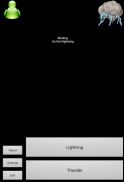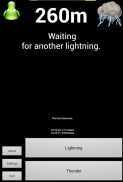




Lightning Calculator Free

Descrição de Lightning Calculator Free
This is the free version of Lightning Calculator.
It includes ad's, and all permissions are related to the ad-module. The paid for version has no ad's.
This program calculate the distance between you and the lightning by using an easy to use interface.
It will show the distanse in meter or feet, and a history of the 5 last distances will give you an indication of the movement of the lightning.
Science of Lightning:
Lightning is an atmospheric electrostatic discharge (spark) accompanied by thunder, which typically occurs during thunderstorms,and sometimes during volcanic eruptions or dust storms.
From this discharge of atmospheric electricity, a leader of a bolt of lightning can travel at speeds of 220,000 km/h (140,000 mph), and can reach temperatures approaching 30,000 °C (54,000 °F), hot enough to fuse silica sand into glass channels known as fulgurites which are normally hollow and can extend some distance into the ground.
There are some 16 million lightning storms in the world every year. Lightning causes ionisation in the air through which it travels, leading to the formation of nitric oxide and ultimately, nitric acid, of benefit to plant life below.
Lightning can also occur within the ash clouds from volcanic eruptions, or can be caused by violent forest fires which generate sufficient dust to create a static charge.
How lightning initially forms is still a matter of debate: Scientists have studied root causes ranging from atmospheric perturbations (wind, humidity, friction, and atmospheric pressure) to the impact of solar wind and accumulation of charged solar particles. Ice inside a cloud is thought to be a key element in lightning development, and may cause a forcible separation of positive and negative charges within the cloud, thus assisting in the formation of lightning.
The irrational fear of lightning (and thunder) is astraphobia. The study or science of lightning is called fulminology, and someone who studies lightning is referred to as a fulminologist.Esta é a versão gratuita do Calculator relâmpago.
Ele inclui anúncio da e todas as permissões estão relacionadas com o módulo ad. O pago para a versão não tem anúncios do.
Este programa de calcular a distância entre você e os relâmpagos, usando uma interface fácil de usar.
Ela vai mostrar a Distância em metros ou pés, e um histórico dos últimos cinco distâncias lhe dará uma indicação do movimento da luz.
Ciência de Lightning:
Relâmpago é uma descarga eletrostática atmosférica (faísca) acompanhada de trovoadas, que normalmente ocorre durante as tempestades, e às vezes durante as erupções vulcânicas ou tempestades de poeira.
A partir desta descarga de eletricidade atmosférica, um líder de um relâmpago pode viajar a uma velocidade de 220.000 km / h (140,000 mph), e pode atingir temperaturas próximas de 30.000 ° C (54,000 ° F), quente o suficiente para fundir areia de sílica em vidro fulgurites conhecidos como canais que são normalmente oco e pode estender a alguma distância para o chão.
Há cerca de 16 milhões trovoadas em todo o mundo a cada ano. Relâmpago provoca a ionização do ar através do qual se desloca, levando à formação de óxido nítrico e, finalmente, o ácido nítrico, um benefício para plantar vida abaixo.
Relâmpago pode também ocorrer dentro das nuvens de cinzas de erupções vulcânicas, ou pode ser causada por incêndios violentos que geram poeira suficiente para criar uma carga estática.
Como um relâmpago forma inicialmente ainda é uma questão de debate: Os cientistas estudaram as causas que vão desde perturbações atmosféricas (vento, umidade, fricção e pressão atmosférica) para o impacto do vento solar e acúmulo de partículas carregadas solares. Gelo dentro de uma nuvem é pensado para ser um elemento chave no desenvolvimento relâmpago, e pode causar uma separação forçada de cargas positivas e negativas dentro da nuvem, auxiliando na formação de um raio.
O medo irracional de um raio (e trovão) é Astraphobia. O estudo ou a ciência do relâmpago é chamado fulminology, e alguém que estuda relâmpago é referido como um fulminologist.

























